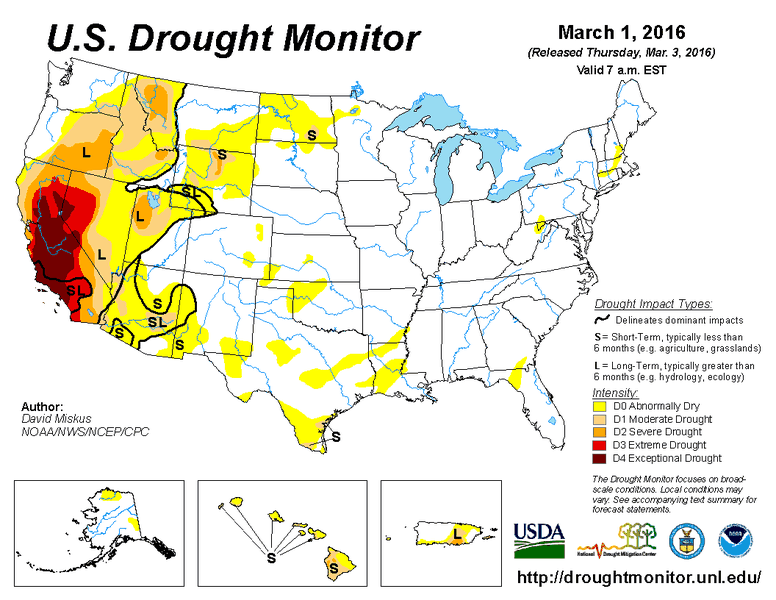Published: April 13,2016
Fooding rain and severe thunderstorms will persist for several days in parts of the Plains beginning Friday lasting through the weekend into early next week.
When winds at jet-stream level don't simply flow generally west to east (in the northern hemisphere), but take large north-south (or south-north) meanders, weather systems producing rain or snow slow down.
 Upper-level
pattern forecast for Sunday, April 17, 2016, featuring an omega block
in the East, trapped low in the Rockies, and deep moisture into the
Plains states.
Upper-level
pattern forecast for Sunday, April 17, 2016, featuring an omega block
in the East, trapped low in the Rockies, and deep moisture into the
Plains states.(MET 101: "Omega Block" Brings Welcomed Warm-Up)
With high pressure both to the northwest and northeast of the stuck low, there's nowhere for the closed low to go fast.
On the east side of that swirling, slow-moving low, deep moisture will be in place from Texas as far north as the southern Canadian prairie.
Let's break down the potential impacts, starting with the severe threat.
Severe Threat Starts Friday
This closed, lumbering low finally pushes some of its upper-level energy and cold air aloft into the High Plains on Friday.Thunderstorms should be rather numerous Friday afternoon and evening in the High Plains from parts of the Dakotas to the rolling plains of West Texas.
These will likely include supercells with large, possibly accumulating hail, damaging winds, and at least a few tornadoes, though, as is often the case, the tornado threat remains somewhat uncertain this far out.

Friday's Severe Threat
A more concentrated severe threat should be in play once the majority of the upper low's energy finally shifts into the Plains, but that timing is still uncertain.
Each day will likely feature at least some scattered severe thunderstorms, but the outlook is further complicated due to the widespread nature of clouds and rain, which may hold down instability in some parts of the Plains.
(MAPS: 7-day National Rain/Snow Forecast)
The Flood Threat
This stagnant pattern with a deep plume of moisture in place is a prime setup for flooding rainfall, even despite parts of the Plains being rather dry, recently (more on that below).As mentioned earlier, there remains some uncertainty regarding how slow the trapped upper low moves. In general, the slower it moves, the greater the potential for heavy rain over the same areas over multiple days.
The map below is a general view of the area where we're expecting the heaviest rain into early next week. Keep in mind this forecast will change as we get nearer to the event, and that locally much heavier amounts may fall where bands of rain or thunderstorms stall for a few hours at a time.
In general, many areas of the Plains from Texas to parts of South Dakota could pick up 2-4 inches of total rainfall through Tuesday, a significant multi-day rain event for the High Plains.

Rainfall Outlook Through Monday Night
(FORECAST: An April Snowstorm Ahead)
 Drought
monitor animation from March 1 through April 5, 2016, illustrating the
developing drought (light tan contour) in the Plains.
Drought
monitor animation from March 1 through April 5, 2016, illustrating the
developing drought (light tan contour) in the Plains.Yet Another Bizarre Flip-Flop
Over the past several weeks, a flash drought, one which develops quickly, has spread across parts of the Plains states.Garden City, Kansas, hadn't seen any measurable rain or snow in over two months since Groundhog Day, until they picked up almost three-tenths of an inch of rain Monday.
The combination of this complete lack of precipitation with persistently warm and windy weather this spring has led to several large wildfires, including the largest fire on record in Kansas, hopping across the border from Oklahoma in late March.
(RECENT FIRES: Imagery of March Wildfire | Early April NW Oklahoma Fire)
Finally, a wetter pattern more typical of early spring will take shape, however, its extremely stagnant nature will lead to extreme precipitation totals in the High Plains.
Thanks to this sluggish, blocked pattern, Garden City, Kansas, could pick up perhaps twice the average April monthly precipitation, potentially even topping the average wettest month of the year, June.
Garden City, Kansas Precip Flip-Flop
Garden City, Kansas Precip Flip-Flop
3-4 inches
Potential rainfall
1.68 inches
Average April precipitation
3.40 inches
Average June precipitation (wettest month)
0.00 inches
Feb. 3 - Apr. 10 precipitation (record driest such period)
No comments:
Post a Comment